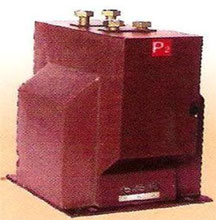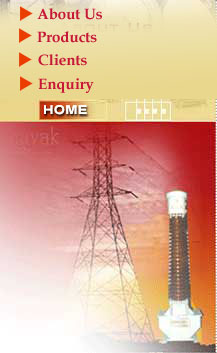GENERAL :
A Current transformer belongs to the series connected class of
electrical apparatus. The system current passes through the
primary winding of Current Transformer and sets up a current
in its secondary winding. Except for a little deviation, this
current is in phase with the primary current and bears a definite
ratio with it. The little deviation is expressed in terms of the
ratio error and phase error of the Current Transformer. Various
international standards on current transformers specify the limits
of these errors for various accuracy classes of the Current
Transformers, the accuracy class depending upon the duty the
current transformer is called upon to perform as also upon the
type of instrument / protective device it is supposed to feed.
Selection of Current Transformer :
The following points need to be considered while selecting
Current Transformers :-
|
 |
|
11 KV CTR |

(a) Ratio :- This is a ratio of the rated primary
current and the rated secondary current and is usually specified
as Rated primary current / Rated Secondary current.
The rated secondary is determined by the rated current of the
apparatus which is to be fed by the Current Transformers. For the
range of current transformers, described here we have standardized
on a rated secondary current of 5 Amps although Current
Transformers with rated secondary current other than 5 Amps are
also manufactured
The rated primary current is determined by the
i) Rated system current.
ii) Fault level at the point in the system where the Current
Transformer is to be located.
Current Transformers


It is immediately apparent that the rated primary current of
the Current Transformer should be at least equal to the rated
system current, although it is usual to specify about 25% higher
rating to cater for increases in the system load (Maximum overload
permitted for a current transformer is 20% of its rated currents.
When substantial changes in the system load are envisaged it is
usual to specify double ratio current transformers, viz 200-1005/5
A.
For multi-ratio current Transformer, the various ratios may
either be obtained by a suitable tap on the secondary winding or
by primary reconnection. If latter is the case, the accuracy of
the current transformation is same the regardless of the connected
ratio. In the former case, however the accuracy is inferior for
the lower ratio.
Fault level at the point in the system where the Current
Transformer is to be located plays an important part in the
selection of rated primary current as this influences the cross
sectional area of the copper conductor to be used for the primary
winding. If the fault level is high, it immediately puts a
limitation on the total number of ampere turns at which a current
transformer can be designed to operate which in turn puts a limit
on the accuracy of current transformation it may therefore happen
that with a given fault level the required accuracy cannot be
obtained for a certain value of the rated primary current . In
such a case next higher standard value of the rated current should
be examined.
(b) Rated Burden : Devices like meters relay coils
etc. require certain voltage to be developed across them for
satisfactory operation. The product of this voltage and the rated
current of the device is called the burden of the device which is
expressed in 'VA'. The burden imposed by each device is readily
available from the makers of the device and the total burden on
the Current Transformers due to the connection of number of such
devices is merely an addition of the burdens imposed by each
device.
c) Class of Accuracy :
Depending on the permissible
ratio and phase errors, current
transformers are classified into
various classes. Specifying an accuracy class higher than the one
required for a particular duty may result in an unduly large and
expensive current transformer. The different standard
specifications for current transformers suggest suitable accuracy
classes for various types of duties.
(d) Accuracy Limit Factor :
Under fault conditions the
current through Current Transformer primary will be many times the
rated current. A proportionate secondary current will be produced
only if the core does not get saturated. An accuracy limit factor
specifies the limit of primary current (protect of rated primary
current and accuracy limit factor) till which the accuracy of
current transformation is within the specified limits. Higher
accuracy limit factors, than required, result into an unduly large
and uneconomical Current Transformer for protective duty an
accuracy limit factor of 10 is usually specified.
(e) Voltage Class :
This specifies the rated system
voltage on which the Current Transformers is to operate. The
system earthing condition, i.e whether the neutral of the system
is solidly grounded or otherwise also needs examination as it
influences the power frequency voltage test level for the Current
Transformers.
Twin and Triple core Current Transformers :
It is usually necessary to have separate current transformers
for metering and protective duty. These Current Transformers can
be combined into one Current Transformer having two separate
secondary windings, one for metering and the other for protection
and a common primary winding thereby resulting considerable
economy. This may further be extended to include three core
Current Transformers. The present leaflet describes single double
and triple core Current Transformers.
Current Transformers for Electrically Exposed Installations
:
The current transformers described are normally suitable for
indoor use. The Impulse voltage withstand test has however been
carried out on some of the designs.Which is the specified test level for 11kv Current Transformers by
I.S.S., D.S.S.
Special Current Transformers.
We shall be pleased to manufacture special Current Transformer
to suit the exact individual requirements. In such case the
following information may please be furnished to us :-
| (a) Ratio of primary to secondary current. |
|
(b) Rated
Burden.
)
Class of Accuracy
)
(c) Accuracy Limit factor
) |
if in doubt, please furnish
details of duty involved. |
| (d) Frequency. |
|
| (e) Voltage class. |
|
| (f) Limiting Dimensions |
|
| (g) Any special conditions and requirements. |
|
| |
|
|



